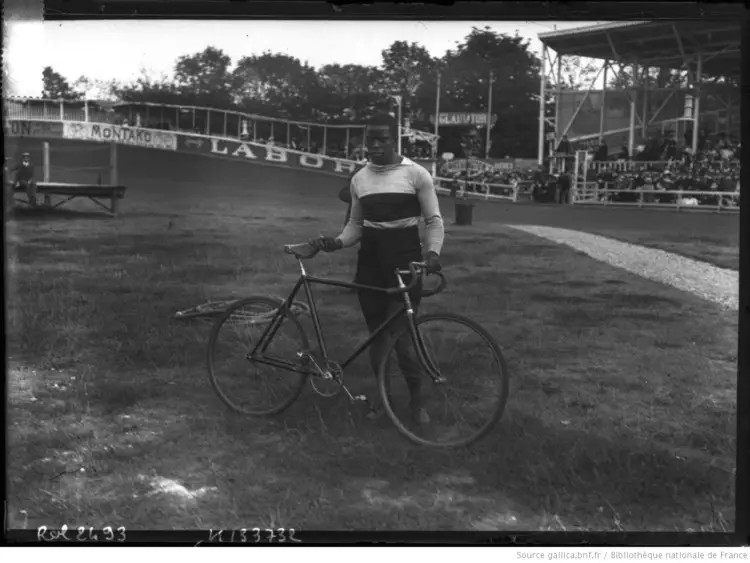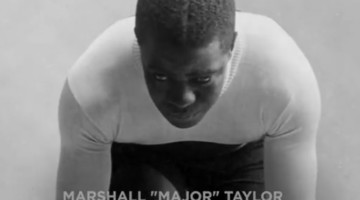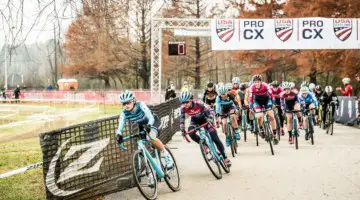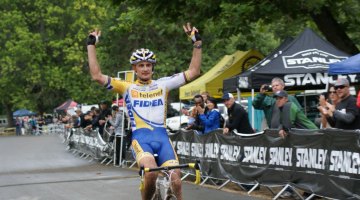Today’s Throwback Thursday is a fortuitous one. The other day, I sat down to start reading “Cycling in Chicago” by Chicago cyclocross racer Chris McAuliffe for a review. Featured prominently in the fascinating chapter on the early days of cycling in the Second City is African-American track legend Marshall “Major” Taylor.
Taylor was a world champion and America’s first black athletic superstar. In the nearly century since his death, he has also been largely forgotten in American sports history.
If, like me, you are largely unfamiliar with the story of Major Taylor, the name is likely at least familiar thanks in part to the Major Taylor Cross Cup hosted by Marian University in Indianapolis each fall. Taylor was born in Indianapolis and the velodrome there is aptly named after him and the race also pays homage to his legend, even if he never raced cyclocross.
After reading McAufliffe’s book, I wanted to learn more about Taylor, so I did some googling. As it turns out, Taylor is getting some press right now from a most unlikely source that includes a mini-documentary with a major media partner to help tell his story to modern audiences.
Read on for more about Taylor, the story of the attention he is getting and a short documentary about one of his toughest races.

Major Taylor was a legend of American track racing. photo: gallica.bnf.fr (public domain)
The Black Cyclone
Marshall “Major” Taylor was born near Indianapolis in 1878 and during his childhood, was taken in by a wealthy Indianapolis family. The family gave him a bicycle, and when they moved to Chicago, Taylor found work at a bike shop. According to legend, Taylor got the nickname “Major” because part of his bike shop duties included putting on a military uniform and doing tricks on his bike.
While in his teens, Taylor started racing on the track. Although it is infinitely hard to comprehend given the state of modern cycling, track racing was a really big deal back then. Venues such as Madison Square Garden would sell out when the big track races were in town and track cyclists were international stars.
Taylor went on to win the 1899 sprint world championship in Montreal at age 20 to become just the second African-American athlete to hold a world title. While facing racism at home—he was banned from racing in much of the South—Taylor became an international star. After winning track Worlds, he was the highlight of a European tour in 1901 and subsequently made a trip to Australia and had return sojourns in Europe as well.
Taylor retired from racing in 1910. He wrote a self-published autobiography “The Fastest Bicycle Rider in the World” in 1928, but a series of bad investments and the Great Depression wiped him out and left him broke. He passed away in 1932 at age 53 and was buried in a simple grave near Chicago. In what was a kind gesture, Frank Schwinn, heir to the Schwinn Bicycle Company, donated money to a group of Taylor’s professional racing peers in 1948 to give him a proper grave at the Mount Glenwood Memorial Gardens outside Chicago.
Shining Light on a Forgotten Legend
We remember Jesse Owens, Jackie Robinson, Muhammad Ali and even his contemporary boxer Jack Johnson, but perhaps because of how he died and the waning popularity of bicycle racing after the early 1900s, Taylor’s name is largely forgotten in the history of great African-American athletes.
However, the world often works in mysterious ways. A few years ago, the Hennessy cognac brand started a “Wild Rabbit” ad campaign with the tag line “Never stop. Never settle.” The ads began in 2012 and have since included boxer Manny Pacquiao and the Piccard family of explorers, among others.
Major Taylor is the topic of Hennessy’s most recent “Wild Rabbit” campaign, with this ad:
The Six Day Race
Cool? Yes. Learn much? Probably not.
Fortunately, Hennessy also partnered with ESPN to produce a mini-documentary about Taylor that includes commentary from BMXer Nigel Sylvester and road racer Ayesha McGowan. Yesterday (and thus the fortuitous nature of this post), ESPN and Hennessy released a video called “The Six-Day Race.”
When Taylor started racing, the biggest track events were six-day races. Think your 24-hour mountain bike race is hard? Try riding in circles for six straight days. (Apparently you still can in Europe) One of the biggest six-day races of the time was held at the Madison Square Garden. In 1896 at age 18, Taylor entered the 28-athlete race and finished 8th. In total, he rode over 1,700 miles.
The “Sports Shorts” documentary is scheduled for broadcast on ESPN at 3 p.m. EDT on Sunday, April 22. ESPN’s programming shows a 30-minute time slot, and the video is only 7-minutes long, so it is at least part of the documentary.
“The Six Day Race” tells the story of Taylor’s grueling endurance race at Madison Square Garden and explores his impact on modern cyclists.
For more on Taylor, there are biographies about his career and life by Conrad and Terry Kerber and Andrew Ritchie and there is also an Australian mini-series called Track of Glory from the 1980s.


























